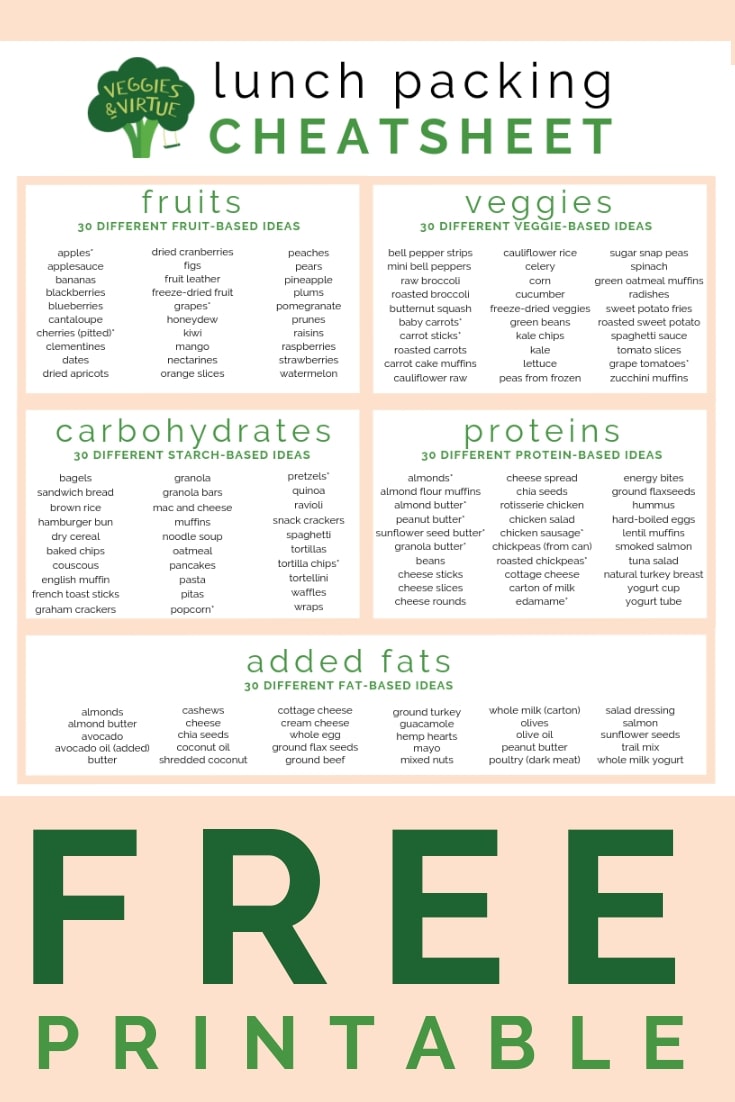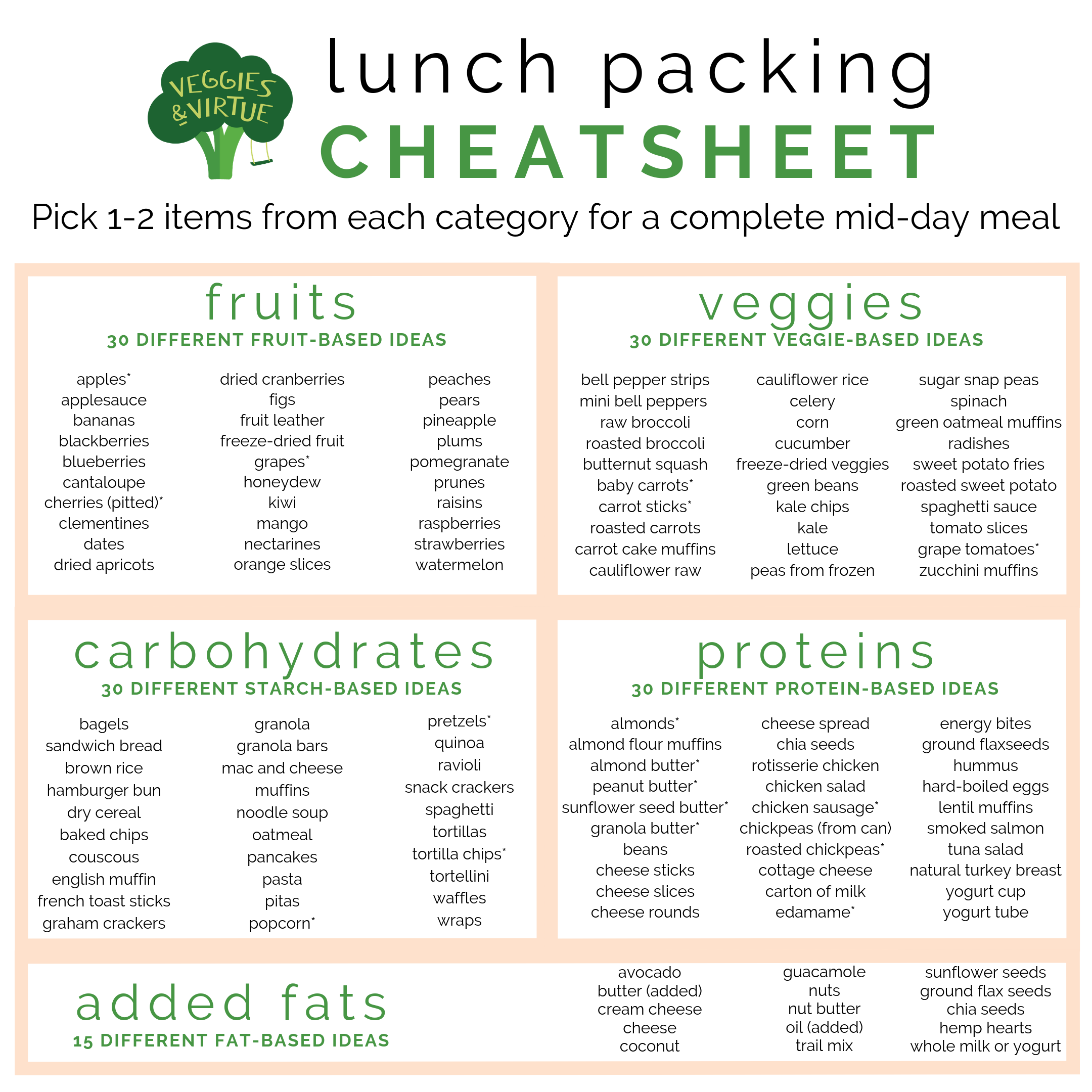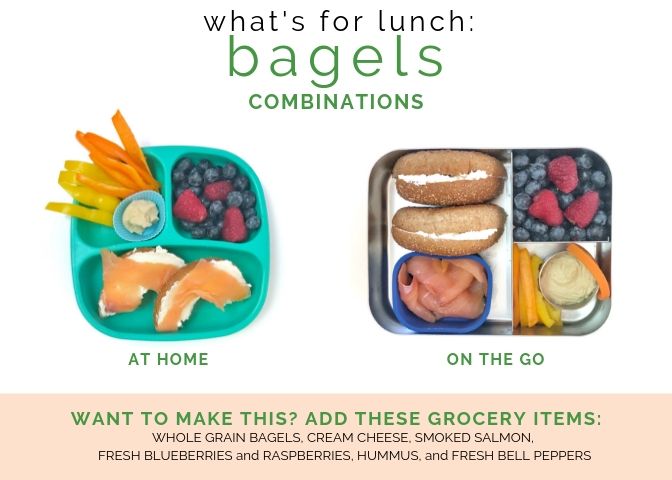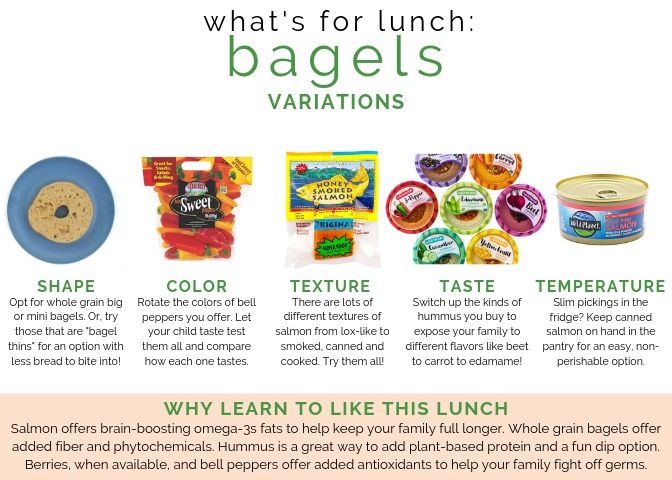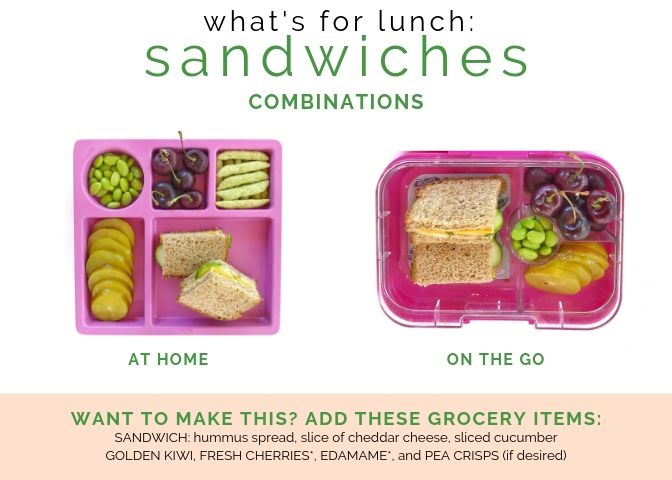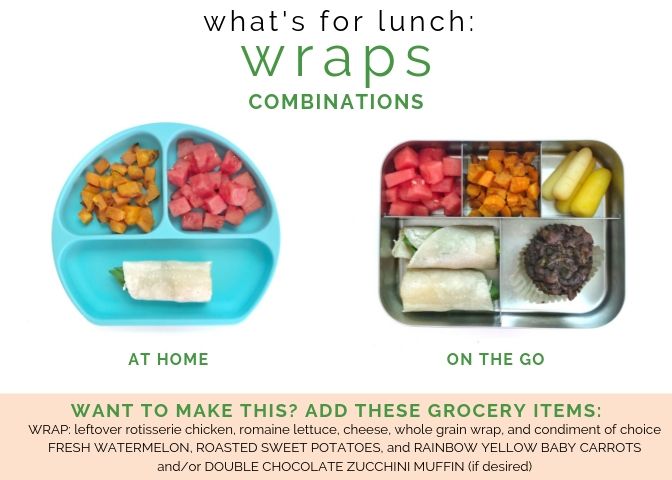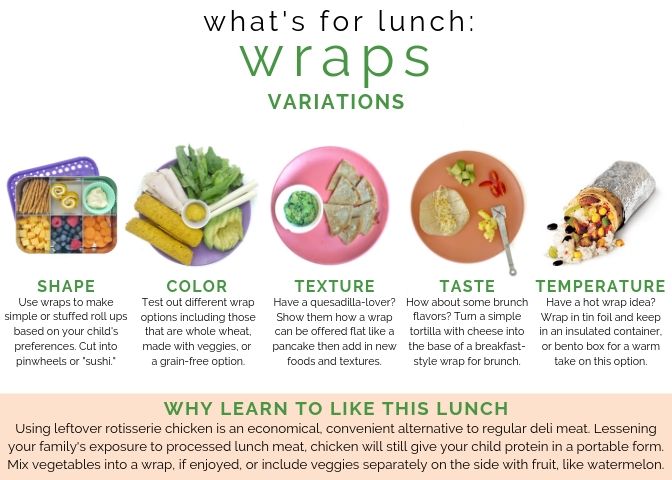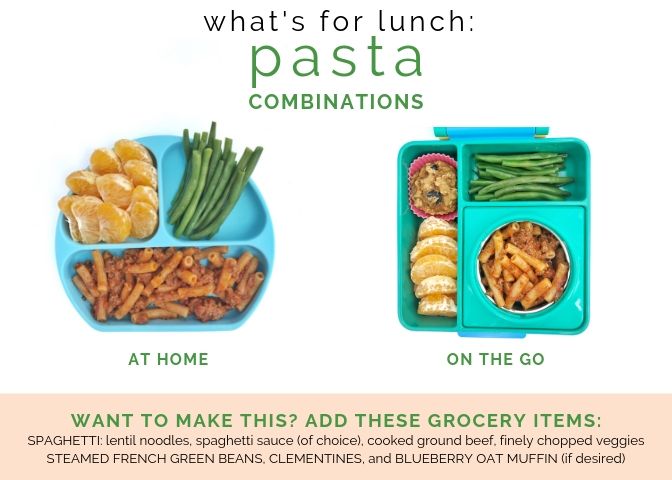Must-Have Lunch Packing Cheat Sheet
With the school year upon us, many families are getting ready to pack school lunches. So to help simplify the process for you, I am sharing my must-have lunch packing cheat sheet (free!) plus several other tips and tricks below. You can download the cheat sheet to help figure out what to offer, then use the other tools to do everything from meal plan to grocery shop to communicate with your child’s teacher about how all foods fit.
Must-Have Lunch Packing Cheatsheet
Do you have all your lunch packing supplies ready?
You can find all of my favorite products to send back to school here.
Once you have your lunch box and accessories ready to go, then comes what to actually pack in the lunch box. That’s what this post will help you accomplish!
What to include in a school lunch
It is easy to default into offering the same foods every day. Instead, try to rotate through a variety of simple staples, as shown in my new Combination Cards [on sale 9/4!]. By leveraging known favorites to include more new foods in your lunch packing rotation, you can continue to expand on what options your child learns to like at lunch so that they are satisfied throughout their school day.
For easy drag and drop ideas of what to pack in your child’s lunchbox, use this free printable (below). It includes one month’s worth of fruit, veggie, protein, carbohydrate, and added fat options to both fill and fuel your child. Just print and post in your kitchen for healthy lunchbox ideas to keep on hand!
What to avoid or limit in school lunches
While there are many foods that may fuel your child better than another, there are a few foods that I stand firming behind needing to avoid altogether or limit in kid’s lunches at school.
Avoid (pea)nuts: Check with your child’s preschool on their nut policy. As needed, avoid all peanuts or nut containing products. If allowed, you can offer other nut butters like almond, cashew, or combinations like Nutzo. If you need to send completely nut-free options, you can utilize a growing list of alternatives like Sunbutter or Granola Butter. Spread thinly on a sandwich, crackers, or add to celery.
For more on peanut-free playdate (or lunch packing!) ideas, visit here.Modify choking hazards: Depending on the age of your child, there are some foods that need to be modified or avoided due to choking risk (under the age of 4). Since a teacher cannot physically watch each bite every child in their class takes, use your best judgement and adapt what options you pack in your child’s lunchbox accordingly for your child's age and feeding stage.
Such potential choking hazards may include: hot dogs, nuts and seeds, chunks of meat or cheese, whole grapes, whole cherry tomatoes, hard or sticky candy, popcorn, chunks of peanut butter, chunks of raw vegetables, and chunks of raw apple.
Limit foods that lack nutrition: Kids rarely have enough time to eat their lunches at school as is, so limit the number of items you send that lack nutrition. While sending chocolate or snack crackers may be fun to include on occasion, consider where you get the most bang for your buck most days of the week. Consider how offering these foods at lunch time impacts your child's overall intake at the meal and fit into their overall diet. Some children may crave these foods more than others in social settings, like school, when eating around their peers. Other children may get a mixed message if/when another caregiver or teacher enforces they eat their "healthy foods first." Decide how such foods fit for your family and child and pack accordingly.
A Rule of Thumb
The goal is to offer: a fruit and/or vegetable, carbohydrate, protein and fat source at lunch.
In general, you want to use this rule of thumb when packing your child’s lunchbox to include a variety of nutrient-dense options for your growing child. If you need more ideas for each of these food groups, get the must-have lunch-packing printable below, which gives you 30 ideas from each of these food groups that you can include! You can also check out my Combination Cards for well-balanced lunch ideas (that I have already come up with for you!).
How to plan and pack ahead
Whether you’re a parent or a child, routines help life go smoother for everyone, especially when it comes to back to school. So see what you can establish as a new rhythm when it comes to packing lunches at home or incorporating in school lunches to make the hustle of school mornings less stressful.
Decide if your child will buy or bring their lunch. Most schools have a school lunch menu online that you and your child can look through at the start of every week or month. Decide which days they will buy lunch, and then plan accordingly for which days you will need to pack lunch. While some families may choose to pack every day, others may see that their children are more willing to eat lunch and more variety when they buy lunches. Play around with what works for your family’s food preferences, budget, and overall lifestyle.
Plan what you will offer: You can use Combination Cards as a guide for what to offer by allocating Monday is sandwiches, Tuesdays is leftover pasta, Wednesday is wraps, Thursday is a snack-style lunch, and Fridays are for a protein-salad. Or, use this free printable in this post as a lunch packing cheat sheet you can drag and drop into a basic meal planner. This helps eliminate the mental energy it takes to come up with new ideas but instead helps you to use what you have on hand to promote more variety over the course of the week.
Pack lunches the night ahead. This seems to be a piece of advice every parent who has gone before us is successful with, and that is to try to pack what you can the night before. You can pack lunches for your kids, or have your child assist in packing their lunch by giving them two options from the food groups listed on the free Lunch Packing Printable Cheat Sheet. Just be sure you leave enough time at night (or in the morning, if you are early risers!) for them to make decisions and be involved in this.
Create a snack drawer in the fridge or pantry. Having a place with “approved” snacks ready to go can be a huge help. Be it assigning a bin in the pantry that is peanut-free (if necessary), or a drawer in the fridge that has a combination of nutrient-dense snack options, can help guide your child to select their own snacks for school from the options you have set out in front of them. For more ideas on this, you can check out all of my #vvSnackDrawer posts.
Help your child navigate the school lunch options. If you have a child who will buy lunch any number of days in the week, consider reading this resource by Jill Castle. It highlights how to help them make wise lunch choices.
Questions to ask about lunch the first few weeks of school
Asking questions about lunch time, particularly as your child gets into the routine of a new school year, will help you learn more about their meal time dynamics while at (pre)school. Particularly if your child’s lunches are coming back uneaten, it is important to understand what dynamics are at play that might be impacting their ability to eat.
Consider inquiring rather than assuming, by asking questions like:
Tell me about lunch time. Where did you sit?
How many kids do you sit with? Did you make any new friends at lunch?
What was the hot lunch today? Did anyone around you have that instead?
Did lunch time feel faster or slower than we do at home?
Was there any wrapper in your lunch that was tricky? How did you problem solve?
Who’s lunch around you looked the yummiest? How come?
I see you ate all of your _____________, but none of your _____________. Can you tell me more about how your tummy made that choice?
Don’t leave without grabbing your free printable!
Perfect for posting up on the fridge so you or your kids can make nourishing choices for any lunch combination.
When schools use different feeding philosophies at lunch
It is very common for schools to emphasize “brain foods first.” With this, they may have a standard rule in the classroom that kids need to eat certain “healthier foods” before they eat their other, potentially “less healthful” preferred foods.
This type of feeding dynamic does not support the Division of Responsibility, and ideally is not used. However, many teachers and educators feel a pressure for children to eat at least something and may see this as the most effective means (in the moment) to ensure that kids aren’t filling up on the more “discretionary” foods in their lunches but rather those that are more nutrient-dense.
If a scenario like this is in place at your child’s school, you might consider:
Talk to your child. Remind your child that food is intended to fuel them for learning and that they need to eat from the options sent. While you want to maintain positive feeding practices at home, help set your child up for success at school by practicing opening the foods being sent and time trials to help them gauge the length of their meal time at school. If your child seems to be running out of time to eat often, also discuss with them that while lunch is a fun time to socialize, eating their lunch is the priority for that time and where else in their day they might be able to make those special conversations happen too (or instead).
Talk to your child’s school. Speaking with the school administrator or your child’s teacher to see if they are open to feeding in a way that better aligns with the Division of Responsibility. If your teacher’s child would be receptive to it, a note like this one from The Feeding Doctor may be helpful to laminate and send (or stick in a Ziplock inside their lunch tote). I wouldn’t send this without first initiating a conversation if/when you know your feeding style conflicts with that used in the school or without follow up, but it can be a helpful reminder of your requests. If your child’s school is receptive to feedback and is open to more training on how to help create healthy feeding norms, this is an excellent printable to provide to your child’s teacher for a reminder in the classroom from The Ellyn Satter Institute (ESI). ESI has several other great resources you can access under your needed category (school, preschool, childcare, etc.) here.
Create or join your school’s wellness committee. Even if it is just helping to refine the “acceptable snack list” to more nutrient-dense items and can align with a Division of Responsibility at snack time, that can be progress. Sally, of Real Mom Nutrition, has some great tips on how to get started with that here.
Need more lunch inspiration?
Click the images below for the digital download of Combination Cards - Lunch Edition

